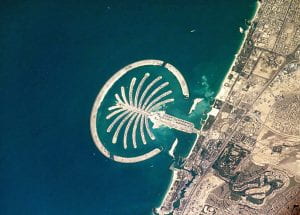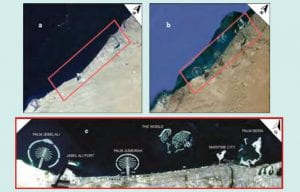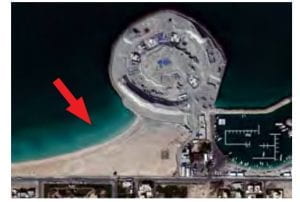Hey urban nomads! Today, I’ll be sharing with you one of my favourite parts of the world – the Middle East! I have always been fascinated with the deserts, pyramids and the culture there and I am slowly but surely conquering Middle Eastern countries – Dubai, Egypt, Israel and Jordan 🙂 and I can’t wait to continue to check the list off.
Anyways, going back to the topic of environmental pollution, creation of artificial islands in the Southern Coast of the Persian Gulf actually brings about environmental consequences. Some artificial lands include Palm Islands in Dubai and Pearl Island in Qatar.

Palm Jumeirah in Dubai
The United Arab Emirates’ attempt to build artificial islands is to develop the tourism industry and attract foreign investment. With artificial islands extending into the sea, environmental pollution is ‘transferred’ from the land to the sea. Marine environment of the Persian Gulf is several times more polluted than open seas.
Modification and loss of natural habitats
Looking at the satellite images below, there has been great morphological differences on the shores due to human activities. The establishments near coast have led to the deposition around the island and have altered the coastline. Artificial islands are formed by using huge ship dredgers and moving depositions led to a formation of huge volumes of suspending particles which can alter the ecosystem (Ghaffari, Habibzadeh, Asfad, & Mousazadeh, 2017).

Changes to Dubai’s coastline due to dredging and building of artificial islands
In order to give way to development, coastal areas which were initially ecologically fertile (mangrove forests, intertidal reef flats) have been degraded, altered or converted into artificial islands – most of which infrastructure development has been based on dredging of marine sediment. A total of 94 million cubic meters for Palm Jumeirah, 135 million cubic meters for The Palm Jebel Ali, and 330 million cubic meters for the World Island were dredged. This amount is enormous when compared to the dredging for Busan Port (the 4th largest container terminal in the world) – only 55 million cubic meters of dredging was done (Ghaffari, Habibzadeh, Asfad, & Mousazadeh, 2017).
Dredging affects the marine ecosystem through the loss of productive habitats and species which also causes the permanent loss of primary nursery grounds for shellfish breeding and fish species in the Persian Gulf. Dredging and disposal of dredged material can cause temporary decrease in water transparency, increase in suspended particles and higher rates of sedimentation. Increased sedimentation causes stress, decrease growth and alter species composition while increasing turbidity due to suspended particles affects the amount of sunlight available for photosynthesis essential to benthic communities like algae and sensitive corals (Lavieren et al., 2011). Suspended particles can also lead to direct loss of benthic fauna through clogging of feeding mechanisms especially filter feeders like mussels and oysters. Besides, dredging will also remobilise and redistribute contaminants such as heavy metals from sediments and these contaminants may re-enter the food chain (Lavieren et al., 2011).
Coastal hydrodynamics
Coastal development affects the natural patterns of water movement and how materials are transported, as well as water quality. Extensive dredging can alter near shore bathymetry and sediment distribution whereas artificial islands can permanently modify water movement and sediment transport. The extent of which will vary according to island shape and orientation. The shape of a shoreline is adjusted by increasing erosion and/ or deposition of sediments (Lavieren et al., 2011).
Using reclaimed sand, the artificial island becomes a new source of sand distribution through wave action and tides while modifying patterns of sedimentation downstream. Careful consideration should be given prior to the development of coastal projects as the consequences of construction can be long lasting or even permanent. For instance, the construction of Palm Jumeirah has created many kilometres of beachfront that must be regularly re-shaped and replenished due to the interruptions in sediment drift (Lavieren et al., 2011).

Interruptions in natural sediment drift – increased deposition of sediments on the left side can modify the natural shape of a shoreline. Red arrow indicates the direction of predominant wave action
In conclusion, the governments of the region of the Persian Gulf must consider the fact that economic benefits from valuable marine sources and tourism are highly dependent on a healthy marine ecosystem without pollution. Therefore, protecting the Persian Gulf environment can only be realised if the countries are reminded of their responsibilities – cooperation and interaction between the countries is crucial to reduce environmental pollution.
References
Ghaffari, K., Habibzadeh, T., Asfad, M. N., & Mousazadeh, R. (2017). Construction of Artificial Islands in Southern Coast of the Persian Gulf from the Viewpoint of International Environmental Law Journal of Politics and Law, 10(2). doi:10.5539/jpl.v10n2p264
Lavieren, H. V., Burt, J., Feary, D., Cavalcante, G., Marquis, E., Benedetti, L. S., . . . Sale, P. (2011). Managing the Growing Impacts of Development on Fragile Coastal and Marine Ecosystems: Lessons from the Gulf.
